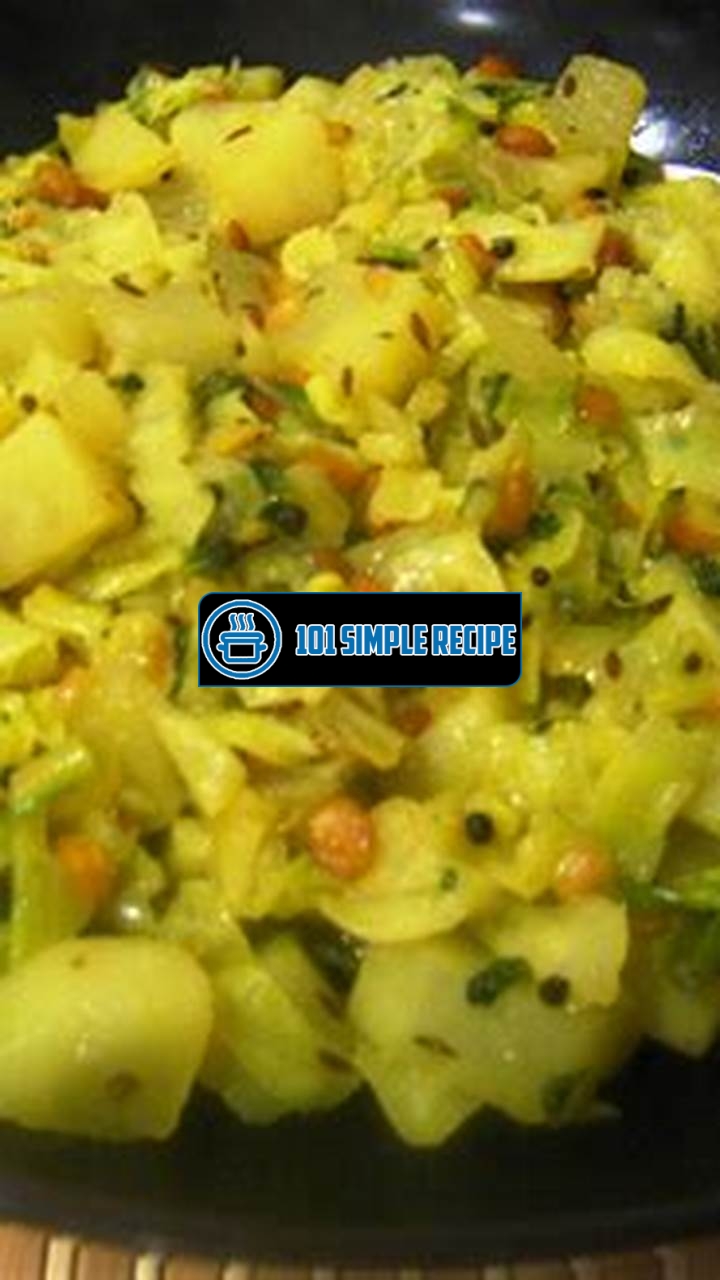Get ready to tantalize your taste buds with savory and healthy South Indian cabbage recipes! ✨ Cabbage, a versatile cruciferous vegetable, takes center stage in these delicious dishes that are packed with flavors and nutrients. Whether you’re a fan of traditional South Indian cuisine or looking to explore new culinary delights, these recipes will not disappoint. Picture-perfect in presentation and bursting with aromatic spices, these cabbage creations are sure to impress both your family and guests. So, let’s dive in and discover the culinary wonders of South Indian cabbage recipes that will leave you craving for more! ️

Exploring Cabbage Recipes from South India
Discover the diverse and flavorful world of cabbage recipes from South India in this comprehensive guide.
The Cultural Significance of Cabbage in South Indian Cuisine
Cabbage holds immense cultural significance in South Indian cuisine. It is a staple vegetable that is extensively used in various dishes, making it an integral part of the region’s culinary traditions. In South Indian households, cabbage is celebrated for its versatility and ability to be incorporated into a multitude of preparations.
South Indian cuisine is known for its vibrant flavors and the intricate use of spices, and cabbage complements these aspects perfectly. Whether it is in a stir-fry or a curry, the addition of cabbage adds a distinct taste that elevates the overall dish. It brings a subtle sweetness and a pleasant crunch to the recipes, creating a delightful culinary experience.
Furthermore, cabbage is a vegetable that is readily available throughout the year in South India. Its accessibility and affordability make it a popular choice for households, both in urban and rural areas. It is a versatile ingredient that can be easily incorporated into everyday meals or used for special occasions.
Note: Cabbage plays a significant role in South Indian cuisine and is revered for its taste, texture, and accessibility.
Health Benefits of Cabbage
Cabbage is not only a flavorful addition to South Indian dishes but also a highly nutritious vegetable. It is rich in vitamins K, C, and B6, as well as fiber, manganese, and folate. These nutrients contribute to the overall well-being and provide several health benefits.
The high fiber content in cabbage promotes healthy digestion and helps maintain a healthy gut. It aids in preventing constipation and supports weight management. Additionally, cabbage is low in calories and contains zero fat, making it an ideal choice for those looking to maintain a balanced diet.
Cabbage is also known for its antioxidant properties, which help protect the body against free radicals that can cause cell damage. The presence of vitamin C in cabbage enhances immune function, while vitamin K ensures proper blood clotting. Consuming cabbage regularly may reduce the risk of chronic diseases and boost overall immunity.
Note: Cabbage is not just delicious, but it also offers numerous health benefits, making it a valuable addition to any diet.
Key Ingredients in South Indian Cabbage Recipes
South Indian cabbage recipes showcase a variety of key ingredients that contribute to their unique flavors. Some of the commonly used ingredients include:
- Mustard seeds: These small black seeds add a distinctive flavor and aroma to the dishes. They are often tempered in hot oil to release their essence.
- Curry leaves: Curry leaves are a staple in South Indian cuisine. They impart a subtle tang and earthy flavor to the cabbage recipes.
- Coconut: Grated coconut is a common ingredient used in South Indian cabbage recipes. It adds a creamy texture and a hint of sweetness to the dishes.
- Turmeric: Known for its vibrant yellow color and numerous health benefits, turmeric is used in South Indian cuisine, including cabbage recipes. It adds a warm, earthy flavor and enhances the overall taste.
- Green chilies: South Indian cuisine is known for its spicy flavors, and green chilies play a significant role in achieving that heat. They add a fiery kick to cabbage recipes.
- Tamarind: Tamarind is a tangy ingredient used to add a sour element to certain cabbage recipes, balancing the flavors and providing a pleasant zing.
The combination of these key ingredients, along with the cabbage itself, creates a symphony of flavors that are unique to South Indian cuisine.
Note: South Indian cabbage recipes utilize a blend of spices and ingredients that contribute to their distinct taste and appeal.
Ranch oyster crackers make a tasty and crunchy snack to serve with cabbage recipes south indian.
Classic South Indian Cabbage Stir-Fry
Master the art of preparing the quintessential South Indian cabbage stir-fry with this step-by-step recipe. Cabbage stir-fry is a popular dish in South India and is known for its flavorful spices and crunchy texture. The combination of spices and seasonings used in this dish gives it a unique and delicious taste that is hard to resist.
Traditional Spices and Seasonings Used in South Indian Cabbage Stir-Fry
In order to achieve the authentic taste of a South Indian cabbage stir-fry, it is important to use the traditional spices and seasonings. The key spices used in this dish include mustard seeds, cumin seeds, curry leaves, and dried red chilies. These spices not only add flavor but also enhance the aroma of the dish.
Additionally, the stir-fry is seasoned with turmeric powder, asafoetida, and salt. The turmeric powder gives a vibrant yellow color to the cabbage and also has numerous health benefits. Asafoetida, on the other hand, lends a unique flavor to the dish and is commonly used in South Indian cuisine.
To add a touch of tanginess, some recipes call for the use of tamarind pulp or lemon juice. This helps to balance the flavors and adds a refreshing zing to the dish.
Tips for Achieving the Perfect Texture
To achieve the perfect texture for your cabbage stir-fry, it is important to follow a few key tips. Firstly, make sure to thinly slice the cabbage so that it cooks evenly and quickly. You can use a sharp knife or a mandoline slicer to achieve thin slices.
It is also important to not overcook the cabbage, as it can become mushy. It should retain a slight crunchiness, giving the dish a pleasant texture. Additionally, make sure to stir-fry the cabbage on high heat to maintain its crispness.
Another tip is to avoid overcrowding the pan while stir-frying. This allows the cabbage to cook evenly and prevents it from becoming soggy. If needed, stir-fry the cabbage in batches.
Variations and Additions to Enhance the Flavor
While the classic South Indian cabbage stir-fry is delicious on its own, there are several variations and additions that you can try to enhance the flavor. One popular variation is adding grated coconut to the stir-fry. The coconut adds a creamy and nutty taste to the dish.
You can also experiment with additional vegetables such as carrots, peas, or bell peppers to make it a more wholesome meal. These vegetables not only add color but also contribute to the nutritional value of the dish.
For those who enjoy a spicy kick, adding green chilies or red chili powder can take the flavor to a whole new level. You can adjust the amount of spice according to your preference.
By mastering the art of preparing the classic South Indian cabbage stir-fry, you can enjoy a delicious and nutritious dish packed with authentic flavors. Follow the traditional spices, tips for achieving the perfect texture, and experiment with variations to create a stir-fry that suits your taste buds. Happy cooking!
Delectable South Indian Cabbage Curry
Indulge in the rich and aromatic flavors of South Indian cabbage curry, highlighting regional spices and techniques. This popular dish is a staple in South Indian cuisine and is loved for its delicious taste and health benefits.
South Indian cabbage curry is known for its unique blend of spices that give it a distinct flavor profile. The use of mustard seeds, curry leaves, and coconut is a common practice in this region, adding depth and complexity to the dish. The cabbage is cooked until it is tender and infused with the flavors of the spices, creating a flavorful and satisfying meal.
There are various regional variations of cabbage curry in South India, each with its own twist on the traditional recipe. In Kerala, for example, they often add grated coconut and turmeric to the curry, giving it a vibrant yellow color. In Tamil Nadu, the curry is typically made with a tomato-based sauce and a combination of spices such as coriander, cumin, and red chili powder.
Regional Variations of Cabbage Curry in South India
South India is known for its diverse culinary traditions, and the regional variations of cabbage curry reflect this diversity. Here are some of the popular versions:
- Kerala Style: The Kerala style cabbage curry is made with a coconut-based sauce and is often served with steamed rice or dosa. The addition of turmeric gives it a lovely golden color.
- Tamil Nadu Style: In Tamil Nadu, cabbage curry is made with a tomato-based sauce and a unique blend of spices. It is often paired with rice or roti.
- Karnataka Style: Karnataka style cabbage curry is made with a combination of spices including mustard seeds, urad dal, and curry leaves. It is typically served with rice or chapati.
Choosing the Right Type of Cabbage for Curry
When it comes to making cabbage curry, choosing the right type of cabbage is crucial to achieving the desired taste and texture. While green cabbage is the most commonly used variety, you can also experiment with other types of cabbage such as Savoy cabbage or Napa cabbage.
Green cabbage has a mild flavor and a crisp texture, making it ideal for curry. It holds its shape well when cooked and absorbs the flavors of the spices beautifully. Savoy cabbage, on the other hand, has a slightly sweeter flavor and delicate leaves, which adds a unique taste and texture to the curry. Napa cabbage, with its lighter and more delicate leaves, can also be used for a different twist on the traditional curry.
Serving Suggestions and Complementary Accompaniments
To enjoy the full flavors of the South Indian cabbage curry, it is traditionally served with steamed rice or Indian bread such as roti or paratha. The combination of soft and fluffy rice or warm and flaky bread complements the rich and spicy flavors of the curry.
For a complete meal, you can also serve cabbage curry with traditional South Indian accompaniments such as coconut chutney, pickle, and papad. These additions provide a burst of flavors and textures that enhance the overall dining experience.
In conclusion, South Indian cabbage curry is a delectable dish that showcases the vibrant flavors of the region. With its aromatic spices and regional variations, it is no wonder that it has become a favorite among food enthusiasts. So, why not try making this delicious curry at home and savor the authentic flavors of South India?
Coca Cola cake is a unique and flavorful dessert that pairs well with cabbage recipes south indian.
Unique Fusion Dishes: Cabbage Fritters with a South Indian Twist
When it comes to cabbage recipes with a South Indian twist, there’s nothing quite like the unique fusion of flavors found in crispy fritters. These delicious snacks take the classic cabbage dish to a whole new level, with the addition of aromatic spices and traditional South Indian ingredients. Get ready to tantalize your taste buds with these mouth-watering cabbage fritters!
Creating the Perfect Batter for Cabbage Fritters
The secret to achieving crispy and flavorful cabbage fritters lies in creating the perfect batter. To begin, finely chop fresh cabbage and set it aside. In a mixing bowl, combine chickpea flour, rice flour, turmeric, chili powder, cumin seeds, and salt. Mix well to ensure that all the spices are evenly distributed throughout the batter. Gradually add water to the dry ingredients, stirring continuously, until a smooth and thick batter is formed.
Pro tip: For extra crunch and flavor, you can also add finely chopped onions, curry leaves, and grated coconut to the batter.
Exploring Variations with Different Types of Cabbage
Cabbage fritters can be made using various types of cabbage, each offering a slightly different taste and texture. Experimenting with different varieties of cabbage can add excitement to your fritter recipes. Some popular options include:
- Savoy cabbage: With its crinkly leaves and mild flavor, Savoy cabbage adds a delicate touch to your fritters.
- Napa cabbage: Known for its sweet and crisp texture, Napa cabbage brings freshness to your fritters.
- Red cabbage: Not only does red cabbage lend a vibrant color to your fritters, but it also provides a slightly tangy taste.
Pro tip: Feel free to combine different types of cabbage to create a colorful and visually appealing platter of fritters.
Dipping Sauces and Chutneys to Complement the Fritters
No fritter is complete without some delicious dipping sauces and chutneys to enhance the flavors. Here are a few options to consider:
- Mint chutney: A refreshing and tangy sauce made from fresh mint leaves, coriander, green chilies, and a hint of lemon juice.
- Coconut chutney: A classic South Indian accompaniment, coconut chutney combines grated coconut with roasted chana dal, green chilies, and tamarind pulp.
- Tomato chutney: A spicy and tangy sauce made from tomatoes, onions, garlic, and a blend of aromatic spices.
Pro tip: Serve a selection of dipping sauces and chutneys alongside your cabbage fritters to give your guests a variety of flavors to choose from.
In conclusion, cabbage fritters with a South Indian twist are a delicious and unique way to enjoy this humble vegetable. By experimenting with different types of cabbage and adding flavorful spices, you can take your fritters to a whole new level. Don’t forget to serve them with a range of dipping sauces and chutneys to complement the flavors. Get ready to impress your family and friends with these delectable South Indian cabbage fritters!
Savory and Spicy South Indian Cabbage Rice
Transform humble cabbage into a flavorful one-pot meal by preparing South Indian cabbage rice. This dish is a popular choice in Southern India, where cabbage is widely available and used in various recipes. Cabbage rice is a delicious and nutritious option that incorporates the distinct flavors of South Indian cuisine.
The Role of Rice and Spices in Cabbage Rice
Rice is the main ingredient in this dish and serves as the base for the cabbage and spices. The rice is typically cooked separately and then mixed with the sautéed cabbage and spices. This allows the rice to absorb the flavors and ensures that each bite is packed with deliciousness.
Spices play a crucial role in achieving the savory and spicy profile of South Indian cabbage rice. Commonly used spices include mustard seeds, cumin seeds, curry leaves, and red chili powder. These spices are usually tempered in oil before adding them to the dish, which releases their aromatic flavors and adds depth to the overall taste.
Enhancing the Flavor with Tadka or Seasoning
To enhance the flavor of cabbage rice, a tadka or seasoning is added at the end of the cooking process. Tadka typically consists of mustard seeds, urad dal, chana dal, dried red chilies, and asafoetida. The tadka is sautéed in oil or ghee, which brings out the flavors of the ingredients and infuses the entire dish with a final burst of deliciousness.
The tadka adds a layer of texture and flavor that takes the cabbage rice to another level. It provides a slightly crispy and aromatic element that complements the softness of the rice and cabbage. This final step truly elevates the dish and gives it that authentic South Indian touch.
Pairing Suggestions and Accompaniments for Cabbage Rice
Cabbage rice is a versatile dish that can be enjoyed on its own or paired with various accompaniments. Here are a few suggestions to enhance your dining experience:
- Raita: Serve cabbage rice with a refreshing side of raita, a yogurt-based condiment. The coolness of the raita complements the spices in the rice and balances out the flavors.
- Papad: Add some crunch to your meal by serving cabbage rice with crispy papads. The combination of the soft rice and the crispy papad creates a delightful contrast of textures.
- Lemon Pickle: A tangy and spicy lemon pickle can be a great accompaniment to cabbage rice. The sourness of the pickle cuts through the richness of the dish, adding a burst of tangy flavor.
These pairing suggestions will enhance your dining experience and take the flavors of the cabbage rice to another level. Feel free to experiment and discover your own favorite combinations!
Note: Cabbage rice is a versatile dish that can be enjoyed as a main course or as a side dish. It can be customized with additional vegetables, such as carrots or peas, to add extra flavor and nutrition.
Try this delicious South Indian cabbage rice recipe and savor the wonderful combination of flavors and textures. It’s an easy and satisfying dish that is sure to please your taste buds!
cabbage recipes south indian are incomplete without a delicious peanut chutney.
Thank you for taking the time to read this article about cabbage recipes from South India. We hope you found some inspiration for your next meal! Don’t forget to bookmark this page and visit again later for more delicious recipes and cooking tips. Happy cooking!
Frequently Asked Questions
Here are some frequently asked questions about cabbage recipes:
| No. | Questions | Answers |
|---|---|---|
| 1. | What are some popular cabbage recipes from South India? | Some popular cabbage recipes from South India include Cabbage Poriyal, Cabbage Kootu, and Cabbage Thoran. |
| 2. | How do I make Cabbage Poriyal? | To make Cabbage Poriyal, heat oil in a pan and add mustard seeds, urad dal, and curry leaves. Then, add chopped cabbage, turmeric powder, salt, and grated coconut. Stir-fry until the cabbage is cooked. Serve hot. |
| 3. | What ingredients are needed to make Cabbage Kootu? | To make Cabbage Kootu, you will need cabbage, moong dal, coconut, cumin seeds, green chilies, and curry leaves. You will also need spices like turmeric powder, red chili powder, and garam masala. |
| 4. | Can I substitute cabbage with any other vegetable in these recipes? | Yes, you can substitute cabbage with other vegetables like cauliflower or broccoli in these recipes. However, the cooking time may vary. |
| 5. | Are cabbage recipes healthy? | Yes, cabbage is low in calories and high in nutrients, making it a healthy choice for your meals. |
| 6. | Can I add additional spices to these recipes? | Absolutely! Feel free to customize the recipes by adding your favorite spices and seasonings to enhance the flavors. |
Cabbage Recipes for South Indian Delights
Try these delicious cabbage recipes from South India to add some vibrant flavors to your meals. Whether you’re a fan of stir-fries, curries, or side dishes, there’s something here to satisfy your taste buds. Don’t forget to share these recipes with your friends and family – they’ll thank you for it!
Jump to Recipe
Cabbage Recipes South Indian

Explore the vibrant flavors of South India with these delicious cabbage recipes. From stir-fried cabbage to flavorful curries, there’s something for everyone.
- 1 small cabbage
- 2 onions
- 3 tomatoes
- 2 green chilies
- 1 teaspoon mustard seeds
- 1 teaspoon cumin seeds
- 1 teaspoon turmeric powder
- 1 teaspoon red chili powder
- Salt to taste
- 2 tablespoons oil
- Fresh coriander leaves for garnish
- Shred the cabbage finely and chop the onions, tomatoes, and green chilies.
- Heat oil in a pan and add mustard seeds and cumin seeds. Let them crackle.
- Add chopped onions and green chilies. Saute until the onions turn golden brown.
- Add chopped tomatoes, turmeric powder, red chili powder, and salt. Cook until the tomatoes become mushy.
- Add the shredded cabbage and mix well. Cook for 5-7 minutes until the cabbage is tender yet crunchy.
- Garnish with fresh coriander leaves and serve hot with rice or roti.






